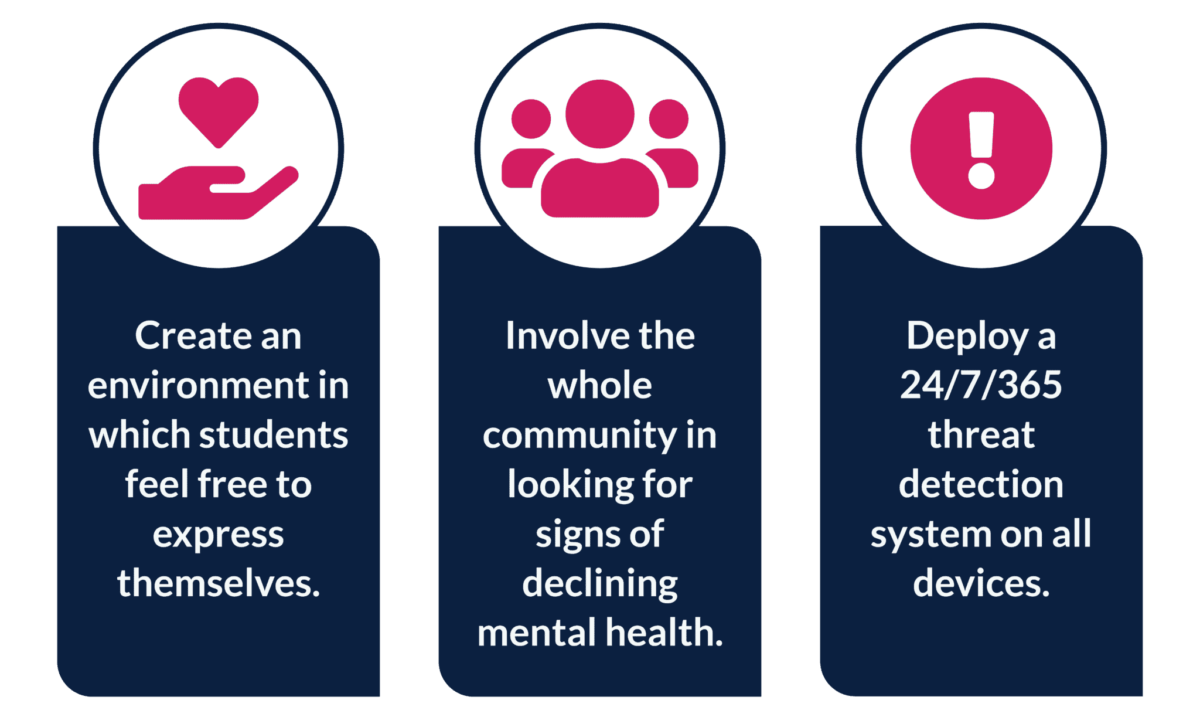Youth Suicide Prevention
Youth Suicide Prevention: Getting Your Students the Care They Need
Watch the Free Webinar
Youth mental health began declining in 2009 and has been steadily worsening ever since. By 2019, more than 13% of adolescents had been diagnosed with a mental health condition, marking more than a 50% increase over the past decade. Today, suicide is a leading cause of death among teens, which means that when it comes to student mental health, school districts remain in an all-hands-on-deck moment.
Everyone—parents, teachers, administrators, IT teams, even bus drivers—must therefore be involved in the effort to help address the student mental health crisis, with particular focus given to suicide prevention. Indeed, according to the most recent data from the American Foundation for Youth Suicide Prevention, nearly 9% of high school students made a suicide attempt in the past year. And it’s not only high school students: for children aged 5-11 suicide is now the eighth leading cause of death.
With such a high-stakes and emotionally charged crisis, it can be hard for districts to know where to start. That’s why Lightspeed Systems® sat down with Amy Grosso, Board Chair for the Central Texas Chapter of the American Foundation for Youth Suicide Prevention, to learn what the experts recommend K-12 school districts do.

Here are three actionable steps all districts can take to help prevent youth suicide.

1. Create an environment in which students feel free to express themselves
Dr. Grosso stressed that districts must create an environment in which students feel comfortable talking about how they really feel.
“Parents often say, ‘My kid’s just not happy. How do I make them happy?’” she said. “Well, you don’t. The child is angry, the child is disappointed. Sit with them and feel the feeling together. Learning not to bypass these hard emotions is a lot of the suicide prevention work.”
A student who has at least one adult they can approach—any adult they trust—when they’re struggling is much more likely to get the help they need in a moment of crisis. “Don’t be afraid to bring up suicide and to invite students to talk about it,” said Dr. Grosso. “It’s a myth that talking about suicide makes students more likely to try it.”
Creating an environment in which students can express themselves without judgment is also a suicide prevention strategy with a beneficial side effect: it helps other students feel comfortable reaching out for help. “I ask parents, ‘Do you ask your kids about their feelings as much as you ask about grades?’” Dr. Grosso said. “It turns out parents usually never ask about feelings.” Doing these “pulse checks,” she explained, gives students a chance to open up while also helping to remove the persistent social stigma surrounding mental health disorders.
2. Have your district’s entire community be on the lookout for signs of declining mental health
When a student dies of suicide, they almost always do so after manifesting identifiable signs. “We break down the signs into three categories,” Dr. Grosso said. “Talk, behavior, mood.”
Warning sign #1: Talk
A student in the midst of a crisis will often begin making inappropriate remarks. Sometimes they will joke about killing themselves or speak lightly about experiencing unbearable pain. “We have to take it seriously every time someone says something like this,” Dr. Grosso said. “That’s not an appropriate way to get attention.” Instead, it may well be a cry for help—and even if it isn’t, it’s better to err on the side of caution. The same is true for the warning signs that often precede violent behavior.
Warning sign #2: Behavior
One should treat dramatic behavioral shifts with equal seriousness. Sometimes students preparing for suicide will give away all their possessions; other students will withdraw from activities they once loved. Any particular student’s change in behavior will be unique to them, so it is important to look for a dramatic shift, not a specific action.
Warning sign #3: Mood
Often manifesting in tandem with alarming remarks and behaviors are sharp shifts in mood. An at-risk student may become consistently irritable, appear to be checked out, or even exhibit a sudden sense of calm. All can be signs that the student is in real danger. As with changes in behavior, the crucial thing is not to look out for a particular emotional effect but for a sudden change.
All the adults in students’ lives should be taught to look for and identify these changes. But it’s not enough to be on the lookout; adults also need to know what to do next if they have concerns or see evidence of student violence or self-harm. Therefore, districts need to have a communication plan in place about who needs to be alerted about any alarming signs. Often, Dr. Grosso noted, it’s the bus drivers who first notice changes in students, so everyone must be empowered to intervene on the student’s behalf.
3. Deploy a 24/7/365 threat detection system on all devices
Unfortunately, these holistic suicide prevention measures will never be enough on their own. Districts must also be prepared to help students on the verge of making a suicide attempt.
Because many warning signs of suicide manifest online, districts need a comprehensive 24/7/365 threat detection system, such as Lightspeed Alert™. Powered by proprietary AI, this solution monitors all student devices for signs of violence, self-harm, and suicide. Lightspeed Alert fully integrates with Microsoft and Google to provide comprehensive monitoring of all online documents, shared images, and social media—anywhere students interact online and exhibit warning signs.
Lightspeed Alert also offers human review by Lightspeed Safety Specialists who examine the context of the alert to evaluate the level of danger. When a threat is deemed imminent, the Lightspeed Safety Specialist will immediately notify designated district or school personnel and emergency authorities.
Threat detection technology saves students’ lives, as Caddo Parish Public Schools learned when Lightspeed Alert helped them to prevent the suicides of two students. In both cases, as soon as the alerts came in and were found to indicate an imminent threat, Lightspeed Safety Specialists immediately contacted Caddo Parish’s district and emergency personnel to help students before they harmed themselves.
Caddo Parish’s IT Team continues to rely on Lightspeed Alert. Not only does it help them protect students, they said, it also frees them from the burden of monitoring and analyzing students’ online activity themselves. Having an external trained specialist tell the district which alerts merit immediate attention allows their IT team to direct their attention and resources to other pressing concerns.

